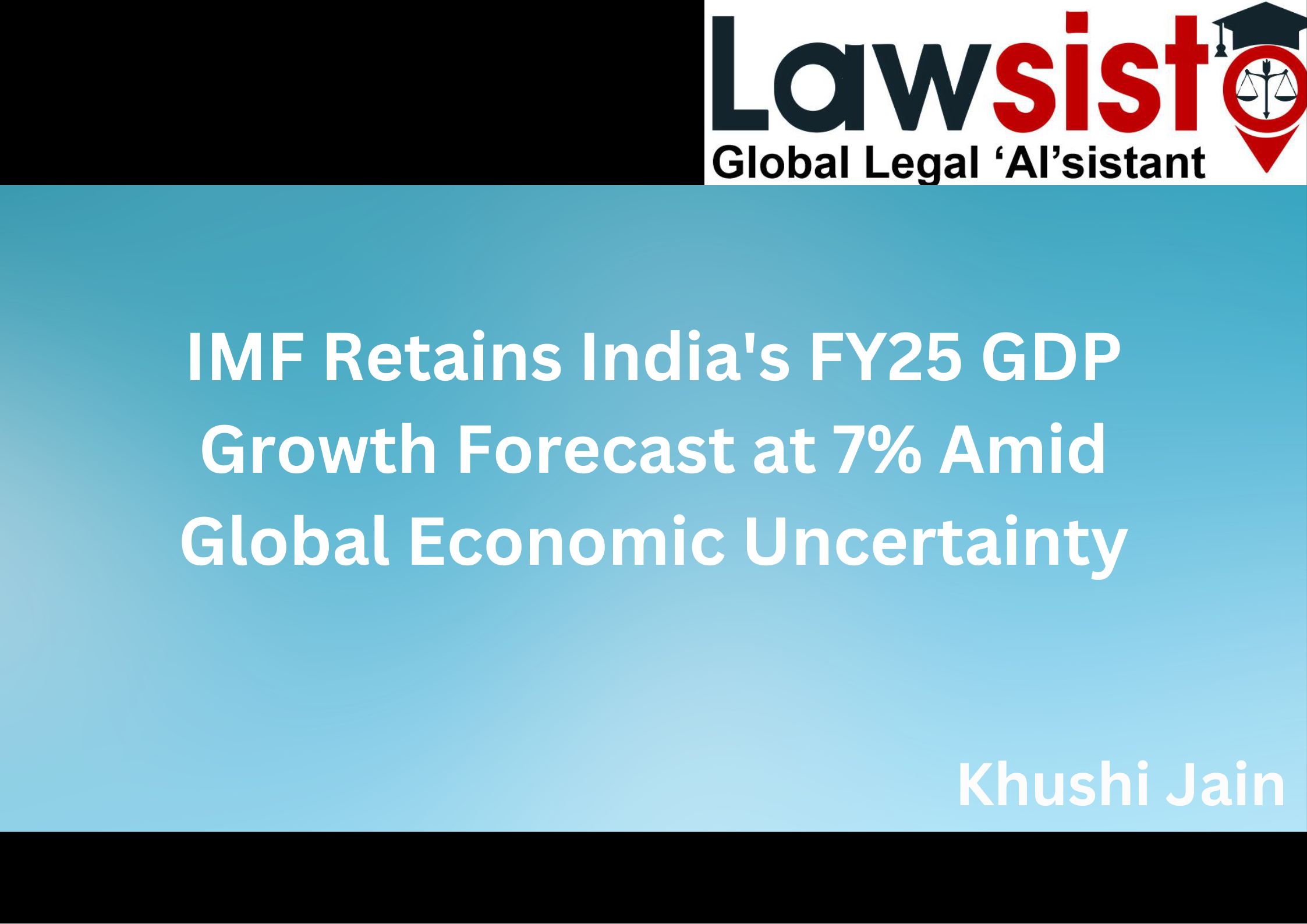Latest News
IMF Retains India's FY25 GDP Growth Forecast at 7% Amid Global Economic Uncertainty

Introduction
In its latest World Economic Outlook report, released on October 22, 2024, the International Monetary Fund (IMF) maintained its growth projection for India’s gross domestic product (GDP) at 7 per cent for FY25. The report highlights that India’s economy continues to show resilience amid global economic challenges, while also adjusting to a post-pandemic normal. The IMF’s outlook comes at a time when other global institutions like the World Bank have revised their forecasts, and inflation and external deficits remain areas of concern for India.
India’s Growth Forecast Remains Unchanged at 7%
The IMF’s report indicates that India’s GDP growth, which was 8.2 per cent in 2023, is expected to moderate to 7 per cent in FY25. This slowdown is primarily attributed to the exhaustion of pent-up demand that had built up during the COVID-19 pandemic, as the economy gradually returns to its potential growth trajectory.
The multilateral agency also projected India’s GDP growth to further decelerate to 6.5 per cent in FY26, mirroring the forecasts from its July 2024 outlook. These figures reflect a tempered but steady growth path for the Indian economy as it adjusts to post-pandemic realities and focuses on structural reforms.
RBI and World Bank's Perspectives on India's Growth Path
Interestingly, the Reserve Bank of India (RBI) has been slightly more optimistic than the IMF. In its most recent monetary policy review, the RBI maintained its FY25 growth forecast at 7.2 per cent, with a projected growth rate of 7.4 per cent for the second half of the fiscal year. This aligns with the robust expansion of 6.7 per cent recorded in the first quarter of FY25, as per government data released in August.
In September 2024, the World Bank updated its growth projection for India, raising it to 7 per cent from its previous estimate of 6.6 per cent. This upward revision by the World Bank reflects India’s ability to maintain a steady growth pace, despite challenges posed by global headwinds and domestic structural issues.
Inflation Forecasts: A Positive Outlook
While India’s GDP growth projections remain stable, inflation continues to be a critical concern. The IMF has offered a slightly more optimistic forecast compared to the RBI regarding inflation. The IMF projects that consumer price inflation will rise by 4.4 per cent in FY25, down from its previous estimate of 4.6 per cent in April 2024. This is a positive outlook, suggesting that inflation may begin to ease and move closer to the RBI’s long-term target of 4 per cent.
Looking further ahead, the IMF anticipates inflation will drop to 4.1 per cent in FY26, a slight revision from its earlier projection of 4.2 per cent. The RBI, on the other hand, has kept its inflation forecast unchanged at 4.5 per cent for FY25. Despite the variance, both institutions seem to agree that inflationary pressures are expected to ease gradually, offering some relief to policymakers.
Rising Inflationary Pressures and Current Account Deficit
Despite this relatively optimistic forecast, India's retail inflation has been on the rise in recent months. In September 2024, retail inflation climbed to a nine-month high of 5.5 per cent, driven largely by soaring vegetable prices. With food inflation remaining a key concern, economists expect inflation to stay elevated in October as well.
On the external front, the IMF has projected that India’s current account deficit will widen in the coming years. The deficit is projected to rise to 1.1 per cent of GDP in FY25, an increase from 0.7 per cent in FY24. The current account deficit is projected to rise further in FY26, reaching 1.3 per cent. A widening current account deficit could put pressure on India’s external balance, especially if global commodity prices remain volatile.
Global Growth Outlook: Steady but with Rising Risks
Globally, the IMF's outlook projects no change in global growth for 2024, maintaining a forecast of 3.2 per cent. The 2025 forecast has been adjusted downward by 0.1 percentage point, bringing it to 3.2 per cent. The IMF highlighted several risks that could affect global growth in the coming years, including the possibility of regional conflicts, especially in the Middle East, which could disrupt commodity markets.
China’s growth forecast for 2024 was revised down to 4.8 per cent from 5 per cent, while the United States is expected to see slightly faster growth. The Euro Area, however, is expected to witness a slowdown, reflecting the varied and uneven recovery paths across different regions.
Rising Geopolitical and Financial Risks
IMF Chief Economist Pierre-Olivier Gourinchas expressed concerns about rising geopolitical tensions and financial risks. He emphasized the potential for regional conflicts, particularly in the Middle East, to exacerbate global economic uncertainties. Additionally, Gourinchas warned that monetary policy could remain tight for longer than expected, which could trigger abrupt tightening in global financial conditions.
RBI’s Monetary Policy: Steady Amid Global Headwinds
Against this global backdrop, the RBI has opted to maintain a cautious stance. In its October 2024 meeting, the central bank’s monetary policy committee decided to keep key interest rates on hold for the tenth consecutive time. The RBI’s focus has been on striking a balance between controlling inflation and fostering economic growth.
With inflation expected to gradually ease and growth forecasts remaining relatively stable, India appears to be navigating a challenging global environment with a steady hand. However, continued vigilance will be required as global risks, such as rising geopolitical tensions and volatile commodity markets, could affect domestic economic conditions.
Conclusion: India’s Steady Path Amid Global Uncertainty
In conclusion, while India’s GDP growth is expected to moderate over the next few years, the outlook remains positive. The IMF’s decision to maintain its growth forecast at 7 per cent for FY25, coupled with easing inflationary pressures, paints a stable picture of India’s economic future. However, challenges such as rising inflation, a widening current account deficit, and global uncertainties continue to pose risks.



















